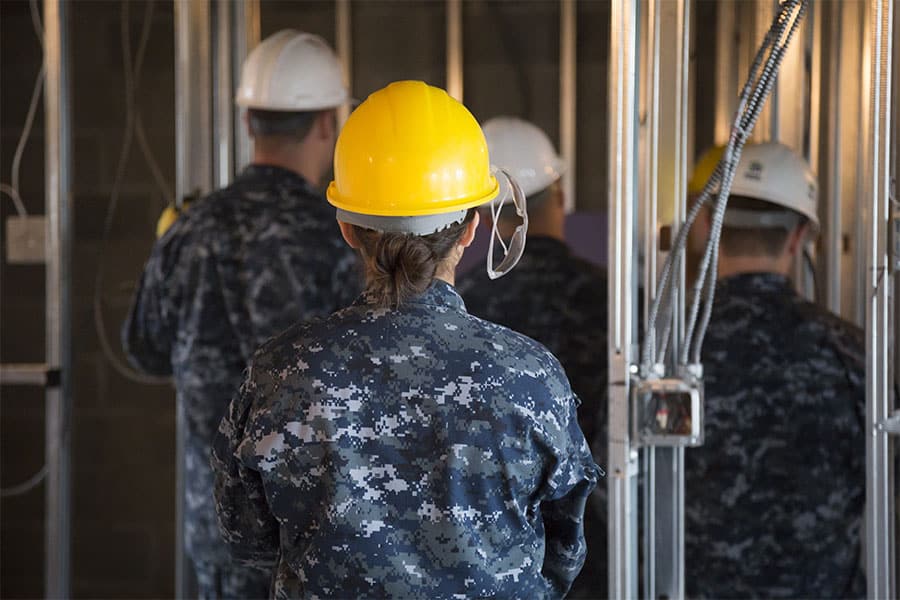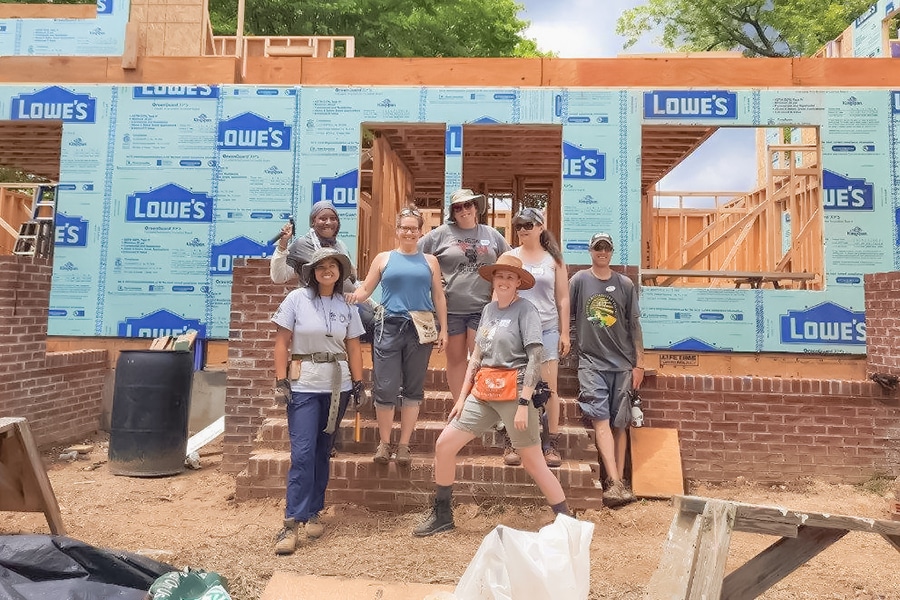In 2008, Jeremy Goodwin was part of a civil infrastructure team tasked with restoring roads and strengthening facilities of a local community.
The project was a unique, once-in-a-lifetime experience for Goodwin. Not because of its scope or particular technique—but because of its location and context.
The location: Iraq.
The context: Goodwin was part of a platoon team in the United States Marine Corps helping establish facilities for the Iraqi army so they could eventually take control of their country from U.S. and coalition forces.
“Our platoon and team were tasked with a lot of the demilitarization,” Goodwin recalled. “That was the time when we would begin to leave Iraq and go to another theatre.”
Today, Goodwin is leading construction projects stateside as a civilian in the private sector. As a project manager for The Christman Company, Goodwin said he applies lessons from his military experience daily, from being conditioned to working long, strenuous hours to having the proper leadership and mental skills to take on unexpected challenges.
“Working multiple shifts. Working 10-12 hours a day—this is nothing,” Goodwin said. “This is nothing compared to Afghanistan. This is nothing compared to Iraq.”
Military + Construction
The marriage between serving in the military and working in construction has always been prominent in Goodwin’s life.
His father and mother were both active-duty physicians in the US Air Force. He has uncles and a grandfather who also served.
“I’ve always had this kind of desire for service and a desire to kind of give back,” Goodwin said. “And so that was kind of the initial inspiration for wanting to be a part of the military was wanting to give that same level of commitment that I saw through multiple generations of my family.”
Goodwin’s family also has a history of working in construction. Another grandfather was a general contractor, while another uncle is currently a construction manager. “I’ve always kind of had this knack for engineering and tinkering and just kind of seeing how things go together,” Goodwin said.
ALSO ON BUILT:
So, when it came time to choose a path as he grew up, Goodwin’s mind was mostly made up.
Goodwin enlisted in the Marines in 2005. He initially thought about following in his parents’ footsteps and serving as a physician, but ultimately decided otherwise. He chose the Marines instead of the Air Force to challenge himself.
“I’d always looked up to and had a high level of respect for those who serve, but also just an additional level of respect for those in the Marine Corps,” Goodwin said. “I just felt that it was something that was very challenging—something to be the best of the best, and that’s what really kind of inspired me to go that route.”
Serving in the Middle East
Goodwin’s initial deployment to Iraq came during the later stages of the conflict in the country, which lasted from 2003-2011 and featured the ousting of the authoritarian government of Saddam Hussein.
“Part of our roles and responsibilities there were to take down some of the infrastructure and restore some of the infrastructure that has been in place for several years, and help that transition from having the US and coalition forces there over to the Iraqi police and Iraqi army,” Goodwin said. “We did a lot of base fortification and simple wood-frame construction where we were building where the Iraqi army and Iraqi police would stay.”
Another part of the mission was to travel roadways and clear them of any improvised explosive devices (IEDs) that may have been placed there.
Following that mission, Goodwin was deployed to Afghanistan in 2010 to help serve as a security presence following the summer surge. “Similar to what we were doing in Iraq, we would provide support from an engineer perspective with infrastructure upgrades, roads, limited bridges, and then again, base fortification,” Goodwin said. “We’d help build out and strengthen some of the facilities of the Afghan forces there, so that when we left, they had the ability to occupy and to maintain that presence and that security on their own.”
(Editor’s Note: Built’s interview with Goodwin took place prior to the United States’ late-summer withdrawal from Afghanistan.)
It was in Afghanistan that Goodwin cemented his military service with his future in construction by taking on the role of squad leader in the Marines’ Combat Engineer Battalion. “The role was presented to me, and it sounded like something very interesting, something that I already had some experience in,” Goodwin said. “There is some demolition involved in being a combat engineer in the Marine Corps. Getting the ability to kind of blow things up and walk away from them was just something that I found fascinating.”
Coming Home
Goodwin completed one final deployment in 2012-13 to Libya after the bombings at the U.S. Embassy in Benghazi. By this time, his military service was nearing its end—but the idea of entering civilian life as a construction worker wasn’t top of mind.
Goodwin instead thought he was interested in a career in the U.S. State Department, the agency that supports the U.S. secretary of state. “That’s why I ended up in Washington, D.C.,” Goodwin said. “I wanted to get as close to the State Department and the FBI that I possibly could, finish my degree and make that transition.”
About partway through earning his degree at nearby George Mason University, however, Goodwin changed his mind. The passion for a lifelong career in the government agency responsible for foreign policy had started to fade, reinforced by the prospect of continued overseas deployments, an aspect of the job not favorable considering his plans to marry and start a family at home.
“I actually made the decision that I’ve always had a passion for engineering; I’ve always wanted to have that as part of my life,” Goodwin said. “So I made the decision to totally pivot and make a change.”
Goodwin graduated from George Mason in 2017 with an undergraduate degree in civil, environmental and infrastructure engineering. During his final two years earning his degree, Goodwin joined Christman, first as an intern in the summer of 2015. “That was a really powerful summer,” Goodwin said. The experience played a large role in solidifying his commitment to a construction career.
With such commitment came continuing promotions for Goodwin at Christman, from assistant project engineer to project engineer, to assistant project manager to his current role as a project manager. As he continued to earn experience in the industry, Goodwin said the parallels between being in the military and working in construction became clearer.
The leadership skills Goodwin learned in the military are particularly transferable to construction, he said. Leading through adversity. Working in challenging, uncertain situations. Collaborating and working on teams. These are all skills that Goodwin said the military instilled in him—and he’s used them often in construction.
“There are a lot of pressures—whether it be financial or schedule or safety—to deliver in construction,” Goodwin said. “And so some of those experiences in construction I’m able to lean back and say, ‘OK, I’ve been through challenging situations before in the military.’”
Goodwin said the team hierarchies in the military and construction are also very similar, as is the service element.
“I think a lot of people are drawn to military service not only for the giving back to their country but also being part of something that’s bigger than yourself,” Goodwin said. “That’s something that these projects that we do in the construction industry—whether small or large—they are bigger than oneself. It takes a team. It takes a community. It takes everybody focused.”
This service element is what keeps Goodwin’s passion for construction strong. And it’s why he says more veterans would prosper in the field once their time in the military ends.
“We all have a common goal in construction,” Goodwin said. “And it’s something that’s really powerful at the end of the day, when you can stand back and you can look at something, you can touch and feel it, and you can see how that building impacts your community and how that impacts the lives of people around you and the generations of people to come. That’s something really, really powerful.”
















